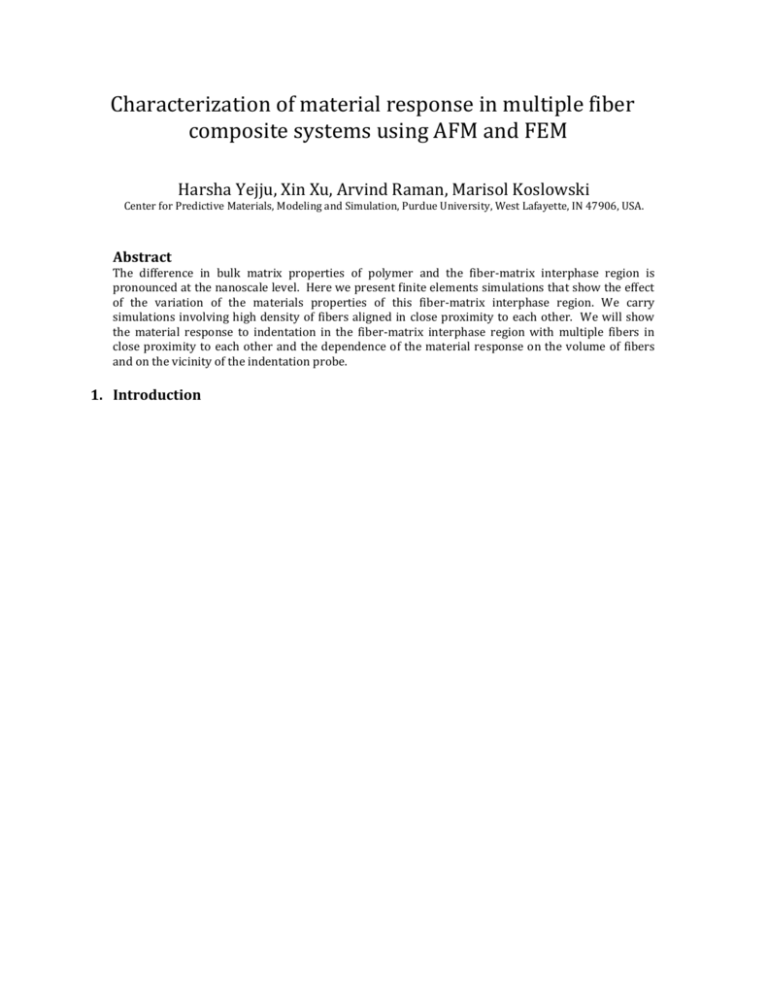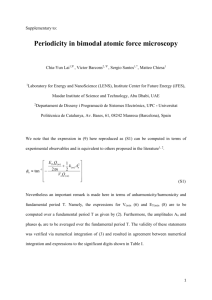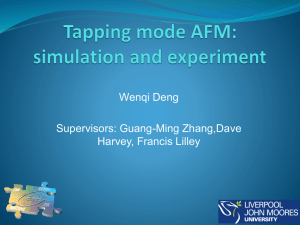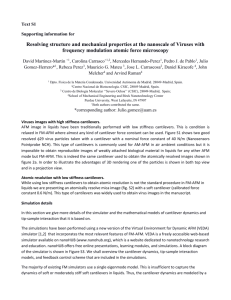Effective stiffness
advertisement

Characterization of material response in multiple fiber composite systems using AFM and FEM Harsha Yejju, Xin Xu, Arvind Raman, Marisol Koslowski Center for Predictive Materials, Modeling and Simulation, Purdue University, West Lafayette, IN 47906, USA. Abstract The difference in bulk matrix properties of polymer and the fiber-matrix interphase region is pronounced at the nanoscale level. Here we present finite elements simulations that show the effect of the variation of the materials properties of this fiber-matrix interphase region. We carry simulations involving high density of fibers aligned in close proximity to each other. We will show the material response to indentation in the fiber-matrix interphase region with multiple fibers in close proximity to each other and the dependence of the material response on the volume of fibers and on the vicinity of the indentation probe. 1. Introduction 2 2. AFM (Xin) 3 3. Processed AFM Results Topography, Amplitude, Effective Stiffness (Harsha) 3.1. Topography Fig. 3. Topography Image (Dataset8) for cantilever stiffness kc = 18.4 N/m, preload force Fpl = 230 nN, and average amplitude on fiber Zfiber = 0.5 nm. Fig. 1. Topography Image (Dataset5) for cantilever stiffness kc = 19.8 N/m, preload force Fpl = 221 nN, and average amplitude on fiber Zfiber = 0.5 nm. Fig. 4. Topography Image (Dataset9) for cantilever stiffness kc = 18.4 N/m, preload force Fpl = 230 nN, and average amplitude on fiber Zfiber = 0.5 nm. Fig. 2. Topography Image (Dataset7) for cantilever stiffness kc = 18.4 N/m, preload force Fpl = 230 nN, and average amplitude on fiber Zfiber = 0.5 nm. 4 3.2. Amplitude Fig. 5. AFM amplitude data for matrix regions (Dataset5) for cantilever stiffness kc = 19.8 N/m, preload force Fpl = 221 nN, average amplitude on fiber Zfiber = 0.3972 nm. Fig. 6. AFM amplitude data for matrix regions (Dataset7) for cantilever stiffness kc = 18.4 N/m, preload force Fpl = 230 nN, average amplitude on fiber Zfiber = 0.5 nm. Fig. 7. AFM amplitude data for matrix regions (Dataset8) for cantilever stiffness kc = 18.4 N/m, preload force Fpl = 230 nN, average amplitude on fiber Zfiber = 0.5 nm. Fig. 8. AFM amplitude data for matrix regions (Dataset9) for cantilever stiffness kc = 18.4 N/m, preload force Fpl = 230 nN, average amplitude on fiber Zfiber = 0.5 nm. 3.3. Effective Stiffness 5 N/m, preload force Fpl = 230 nN, average amplitude on fiber Zfiber = 0.5 nm. Fig. 9. Normalized 2-dimensional effective stiffness plot (Dataset 5) for cantilever stiffness kc = 19.8 N/m, preload force Fpl = 221 nN, average amplitude on fiber Zfiber = 0.3972 nm. Fig. 10. Normalized 2-dimensional effective stiffness plot (Dataset 7) for cantilever stiffness kc = 18.4 N/m, preload force Fpl = 230 nN, average amplitude on fiber Zfiber = 0.5 nm. Fig. 11. Normalized 2-dimensional effective stiffness plot (Dataset 8) for cantilever stiffness kc = 18.4 Fig. 12. Normalized 2-dimensional effective stiffness plot (Dataset 9) for cantilever stiffness kc = 18.4 N/m, preload force Fpl = 230 nN, average amplitude on fiber Zfiber = 0.5 nm. 6 4. Finite Element Procedure and Results (Harsha) 4.a. Finite Element Method Data Analysis Procedure Normalized Stiffness: Normalized stiffness, a measure of the localized stiffness of the composite RVE relative to a bulk matrix sample (i.e. entire RVE with identical mesh is filled with matrix material) was previously coined by Bogetti et al. to characterize the indentation response in the interphase region in a single fiber composite system. (Need to clean up following section) Displacement at point of application of load for a half-space is given by d P 1 2 Er (1) In equation (1) it is clear to see that as ‘r’ approaches zero the displacement at the point approaches infinity. Furthermore, 7 oscillations due to mesh sensitivity were observed in the preliminary results for displacement. To address this mesh sensitivity it was necessary to relate the element size and nodal displacement at the point of application of the load. The relationship between element size, Le, and node displacement d for a unit point load were found by Bogetti et. Al. [1] to be: d AP ELe (2) To solve the problem of the singularity, taking the ratio of displacements of two different materials with same concentrated load and same Poisson’s ratio shows that the ratio of the finite element displacements will converge to the same limit as that based on the theory of elasticity. P (1 2 ) d1 E1r E 2 2 d 2 P (1 ) E1 E2 r (3) AP d1 E1Le E2 AP E1 d2 E2 Le (4) Hence, the following formulation was used to normalize stiffness [1]: E1 P d1 (1) The stiffness of the composite system, E1 , is calculated using equation (1) where P is the applied load and d1 is the deflection at point where load is applied on the composite system. E2 P d2 (2) The stiffness of the bulk matrix system, E2 , is calculated using equation (2) where P is the applied load and d2 is the deflection at point where load is applied on the bulk matrix system. Normalized stiffness formula is displayed as equation (3). E d 1 2 E2 d1 (3) The bulk sample is the exact same FEM (with identical meshing) as shown in geometry except with uniform bulk matrix properties assigned to the whole model, i.e. volume of mesh previously containing fiber is also assigned bulk matrix properties. Effective stiffness: The effective stiffness is an extension of the normalized stiffness to accommodate the cantilever stiffness of the AFM. The normalized stiffness characterization remains valid at this adjusted level due to the small magnitude of the forces (~0.05μN-0.10 μN), which are well within the elastic regime of the constitutive model. (Note: Show some proof of the test conducted to prove response of analytic model is in the linear elastic regime. By performing FEM runs it was found that material response was linear for forces in the range of 0.01μN-1μN.) 4.b. Finite Element Mesh and Boundary Conditions 8 The meshes generated in PATRAN/ANSYS were subsequently solved using the open source Finite Element Analysis Program (FEAP) software. 8-noded threedimensional linear brick elements were used for the analysis. Since the loading force is in the axial direction, the relevant periodicity boundary conditionsi for normal loading case were imposed on the RVE to simulate the presence of other fibers (i.e. displacements normal to the face of the RVE on the 4 transverse faces and back face were constrained to be zero). The dimension of the fiber in both RVE configurations is the same 3 m and is well within the specified range for the experimental sample. The hexagonal array configurations considered in this analysis matched the volume fraction of 0.58 provided by the manufacturer. However, the square array RVE had a volume fraction significantly smaller (~0.29). Despite this significant difference in volume fraction the predicted material response is nearly identical for both square and hexagonal RVE’s. For a perfectly bonded system, this result proves the increased stiffness gradient in the matrix region, arising due to fiber constraint, is highly localized to a narrow thickness around the fiber. Figure: Normalized stiffness vs. radial distance from fiber for different volume fractions. Furthermore, for same RVE dimensions and mesh the material response due to the indentation response for a transversely isotropic fiber and isotropic fiber are nearly identical. Table ___ shows the material properties and dimensions of geometry used for each model and figure ___ shows the corresponding material response respectively. Figure: Normalized stiffness vs. radial distance from fiber for different fiber 3D constitutive equations Modeling of imperfect bond Subsequently, the mesh was changed by inserting regions of constant radial thickness around the fiber to represent the imperfectly bonded interphase. The following characteristics of (a) interphase thickness (varied between 200-1000 nm for each interphase) (b) Young’s modulus of interphase EI (Em premultiplied by some factor) and (c) number of interphases were parameterized to simulate the different gradients observed in the AFM experiments. The parameters used to simulate the imperfectly bonded zones have been listed in the tables below. 9 4.c. FEM Results Fig. 15. Effective stiffness against distance to closest fiber in matrix regions (Dataset8) for cantilever stiffness kc = 18.4 N/m, preload force Fpl = 230 nN, average amplitude on fiber Zfiber = 0.5 nm. Fig. 13. Effective stiffness against distance to closest fiber in matrix regions (Dataset5) for cantilever stiffness kc = 19.8 N/m, preload force Fpl = 221 nN, average amplitude on fiber Zfiber = 0.5 nm. Fig. 14. Effective stiffness against distance to closest fiber in matrix regions (Dataset7) for cantilever stiffness kc = 18.4 N/m, preload force Fpl = 230 nN, average amplitude on fiber Zfiber = 0.5 nm. Fig. 16. Effective stiffness against distance to closest fiber in matrix regions (Dataset9) for cantilever stiffness kc = 18.4 N/m, preload force Fpl = 230 nN, average amplitude on fiber Zfiber = 0.5 nm. 10 4.d. Averaged Effective Stiffness Fig. 20. Dataset 7 Fig. 17. Dataset 5 Fig. 21. Dataset 8 Fig. 18. Dataset 5 Fig. 22. Dataset 8 Fig. 19. Dataset 7 11 Fig. 23. Dataset 9 Fig. 26. Dataset 5 Fig. 24. Dataset 9 Fig. 27. Dataset 5 4.e. Imperfectly bonded zone Fig. 25. Dataset 5 Fig. 28. Dataset 5 12 Fig. 29. Dataset 5 5. Conclusion Note: It was necessary to use this normalization method because the application of a point load that was used to simulate the indentation probe is in reality a distributed load. The next stage is to simulate the indentation with a distributed load using contact analysis. Note: The present model successfully characterizes the increased stiffness in the matrix region observed experimentally from AFM experiments. It still remains of academic interest to characterize the response of the AFM in the fiber region of the composite. The limitation of the present model stems from a lack of an analytical model to predict the displacement due to a point force on a transversely isotropic material medium. Volume fraction does not affect the effective stiffness values. This can be explained by the very narrow width that the interphase region has in the unsized carbon fiber reinforced composite system being studied. 13 Acknowledgements References 14 Sun C.T. , Vaidya R.S. Prediction of composite properties from a representative volume element i







